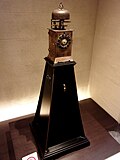Japanese clock
The Japanese clock is a device made to tell the time according to Japanese tradition.[1]
These clocks were introduced to Japan via Jesuit missionaries in the 16th century.[1]
In 1612, the clockmaker of Philip II of Spain created a working timepiece which became a gift for Tokugawa Ieyasu.[1]
One of the major features of the Japanese clock is that it has a mechanism for measuring unequal temporal hours. Usual clock tells hours at same intervals, but in the Japanese traditional timekeeping practice, a day had six daytime units from sunrise to sunset and six night units from sunset to sunrise. Then the Japanese clock was designed to adapt to this practice.[2]
Japanese Clock Media
Two separate foliot balances allow this 18th-century Japanese clock to run at two different speeds to indicate unequal hours.
Tanaka Hisashige's 1851 myriad year clock displays Japanese, equal hour, and calendar information.
The traditional Chinese 12 Earthly Branches and 24 Cardinal Directions; the 12 Earthly Branches are the basis for the zodiacal assignments of the Japanese hours.
References
- ↑ 1.0 1.1 1.2 Nussbaum, Louis-Frédéric. (2005). "Clocks" in Japan Encyclopedia, p. 132.
- ↑ Shibayama, Miyuki. "~和時計の暮らし~". Archived from the original on 2016-04-05. Retrieved 2016-02-02.










